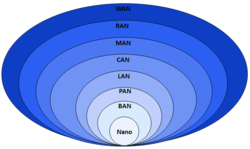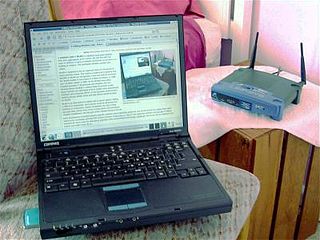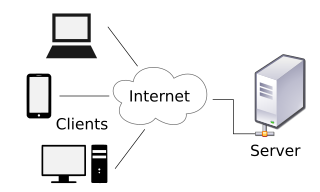| Computer network types by spatial scope |
|---|
 |
An internalnet is a computer network composed of devices inside and on the human body. Such a system could be used to link nanochondria, bionic implants, wearable computers, and other devices.
| Computer network types by spatial scope |
|---|
 |
An internalnet is a computer network composed of devices inside and on the human body. Such a system could be used to link nanochondria, bionic implants, wearable computers, and other devices.
| This computer networking article is a stub. You can help Wikipedia by expanding it. |

In computer architecture, a bus is a communication system that transfers data between components inside a computer, or between computers. This expression covers all related hardware components and software, including communication protocols.
In computing, a device driver is a computer program that operates or controls a particular type of device that is attached to a computer. A driver provides a software interface to hardware devices, enabling operating systems and other computer programs to access hardware functions without needing to know precise details about the hardware being used.

An operating system (OS) is system software that manages computer hardware, software resources, and provides common services for computer programs.

A personal area network (PAN) is a computer network for interconnecting devices centered on an individual person's workspace. A PAN provides data transmission among devices such as computers, smartphones, tablets and personal digital assistants. PANs can be used for communication among the personal devices themselves, or for connecting to a higher level network and the Internet where one master device takes up the role as gateway. A PAN may be wireless or carried over wired interfaces such as USB.

A wireless LAN (WLAN) is a wireless computer network that links two or more devices using wireless communication to form a local area network (LAN) within a limited area such as a home, school, computer laboratory, campus, or office building. This gives users the ability to move around within the area and remain connected to the network. Through a gateway, a WLAN can also provide a connection to the wider Internet.
A network operating system is a specialized operating system for a network device such as a router, switch or firewall.

Network topology is the arrangement of the elements of a communication network. Network topology can be used to define or describe the arrangement of various types of telecommunication networks, including command and control radio networks, industrial fieldbusses and computer networks.

In computing, a server is a computer program or a device that provides functionality for other programs or devices, called "clients". This architecture is called the client–server model, and a single overall computation is distributed across multiple processes or devices. Servers can provide various functionalities, often called "services", such as sharing data or resources among multiple clients, or performing computation for a client. A single server can serve multiple clients, and a single client can use multiple servers. A client process may run on the same device or may connect over a network to a server on a different device. Typical servers are database servers, file servers, mail servers, print servers, web servers, game servers, and application servers.
The Address Resolution Protocol (ARP) is a communication protocol used for discovering the link layer address, such as a MAC address, associated with a given internet layer address, typically an IPv4 address. This mapping is a critical function in the Internet protocol suite. ARP was defined in 1982 by RFC 826, which is Internet Standard STD 37.

In the context of telecommunications, a terminal is a device which ends a telecommunications link and is the point at which a signal enters and/or leaves a network. Examples of equipment containing network terminations are telephones, fax machines, computer terminals and network devices, printers and workstations.
Computer science and engineering (CSE) is an academic program at some universities that integrates the fields of computer engineering and computer science. It is a sub-field of electronics engineering, focusing the digital electronics domain with added courses in computer architecture, processor design, operating systems, high-performance computing, parallel processing, computer networks and embedded systems. CSE programs also include core subjects of computer science such as theory of computation, design and analysis of algorithms, data structures and database systems. The program aims at designing, developing and troubleshooting computing devices and systems, focusing the underlying fundamental issues in the most efficient and effective way. Emerging technologies like artificial intelligence, machine learning and data science are also covered under these programs.

Mobile computing is human–computer interaction in which a computer is expected to be transported during normal usage, which allows for transmission of data, voice and video. Mobile computing involves mobile communication, mobile hardware, and mobile software. Communication issues include ad hoc networks and infrastructure networks as well as communication properties, protocols, data formats and concrete technologies. Hardware includes mobile devices or device components. Mobile software deals with the characteristics and requirements of mobile applications.

A mobile device is a computer small enough to hold and operate in the hand. Typically, any handheld computer device will have an LCD or OLED flatscreen interface, providing a touchscreen interface with digital buttons and keyboard or physical buttons along with a physical keyboard. Many such devices can connect to the Internet and interconnect with other devices such as car entertainment systems or headsets via Wi-Fi, Bluetooth, cellular networks or near field communication (NFC). Integrated cameras, the ability to place and receive voice and video telephone calls, video games, and Global Positioning System (GPS) capabilities are common. Power is typically provided by a lithium battery. Mobile devices may run mobile operating systems that allow third-party apps specialized for said capabilities to be installed and run.

A client is a piece of computer hardware or software that accesses a service made available by a server. The server is often on another computer system, in which case the client accesses the service by way of a network.
In telecommunications networks, a node is either a redistribution point or a communication endpoint. The definition of a node depends on the network and protocol layer referred to. A physical network node is an electronic device that is attached to a network, and is capable of creating, receiving, or transmitting information over a communications channel. A passive distribution point such as a distribution frame or patch panel is consequently not a node.
Networking hardware, also known as network equipment or computer networking devices, are electronic devices which are required for communication and interaction between devices on a computer network. Specifically, they mediate data transmission in a computer network. Units which are the last receiver or generate data are called hosts or data terminal equipment.

A computer network is a digital telecommunications network which allows nodes to share resources. In computer networks, computing devices exchange data with each other using connections between nodes. These data links are established over cable media such as twisted pair or fiber-optic cables, and wireless media such as Wi-Fi.
A network host is a computer or other device connected to a computer network. A host may work as a server offering information resources, services, and applications to users or other hosts on the network. Hosts are assigned at least one network address.
A computer is a machine that can be instructed to carry out sequences of arithmetic or logical operations automatically via computer programming. Modern computers have the ability to follow generalized sets of operations, called programs. These programs enable computers to perform an extremely wide range of tasks. A "complete" computer including the hardware, the operating system, and peripheral equipment required and used for "full" operation can be referred to as a computer system. This term may as well be used for a group of computers that are connected and work together, in particular a computer network or computer cluster.
In computing, input/output or I/O is the communication between an information processing system, such as a computer, and the outside world, possibly a human or another information processing system. Inputs are the signals or data received by the system and outputs are the signals or data sent from it. The term can also be used as part of an action; to "perform I/O" is to perform an input or output operation.